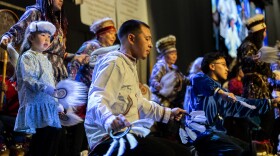-
Quyana sold out both nights. It’s now in its forty-third year.
-
The show is part of the annual Arctic Encounters Summit and transformed the Anchorage Museum into a runway, showcasing Indigenous artists, designers and models.
-
About 300 people packed into the bleachers at June Nelson Elementary School on a Friday afternoon — a mix of students and teachers with a few graduates who are now in their thirties. Resting on a table in front of Assistant Principal Corey Shepherd, there was a three-foot-tall metal cylinder.
-
From aches after berry-picking to back problems from hauling caribou, Lewis Pagel says he's probably treated at least half the Kotzebue’s residents.
-
Largely self-taught, Keats walked in two worlds, combining traditional and Western medicine. She was born in a sod house on the Noatak River in 1907 and learned from anatomy books and from processing caribou and other animals. She began practicing medicine in her 20s and worked as a midwife, helping women deliver babies. A large part of her knowledge came from listening to older generations.
-
Norma Ballot was one of the sign’s designers.“The old sign? It needed help,” said Norma Ballot, one of the sign’s designers. “The old sign looked too much federal-y style.”
-
Ilakucaraq is in its third year. The program has several components, but its primary goal is for Alaska Native students to learn about other cultures and communities in the state.
-
“We're up in the Arctic Circle, it's dark, it's cold, and people get bored and lonely, so mental health is a very important thing to talk about,” Santos said. “Kids can know from such a very young age that they are queer people, and those kids deserve to feel accepted.”
-
“In the lower 48, there's a common saying, ‘it takes a village,’” Woods said. “But no other athlete had to grow up the way I grew up. They don't know what it's like to be out at 40-below and chase caribou.”
-
The award honors women who are “using their voices for change” and comes with feature stories about each woman. This year, author Lily Tuzroyluke was Alaska’s awardee.
Play Live Radio
Next Up:
0:00
0:00
Available On Air Stations










